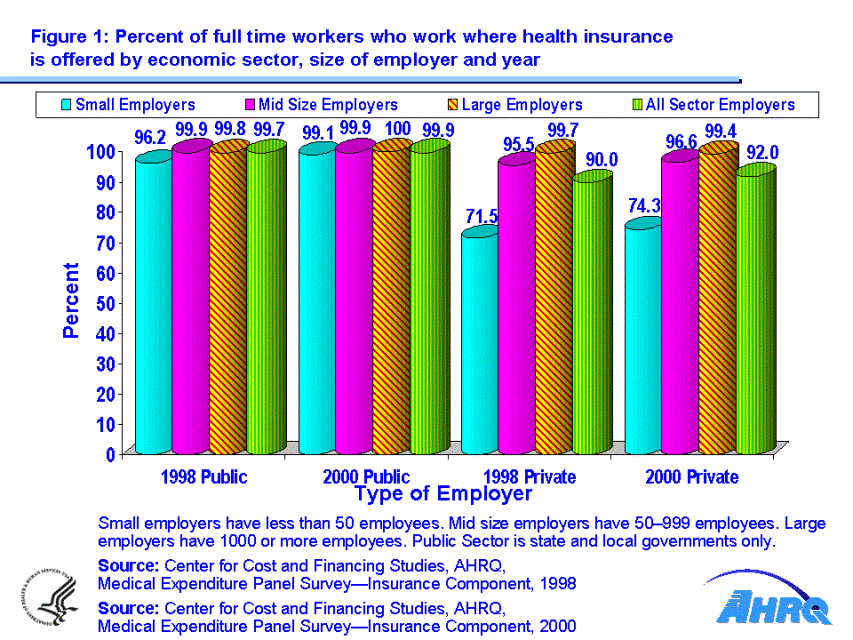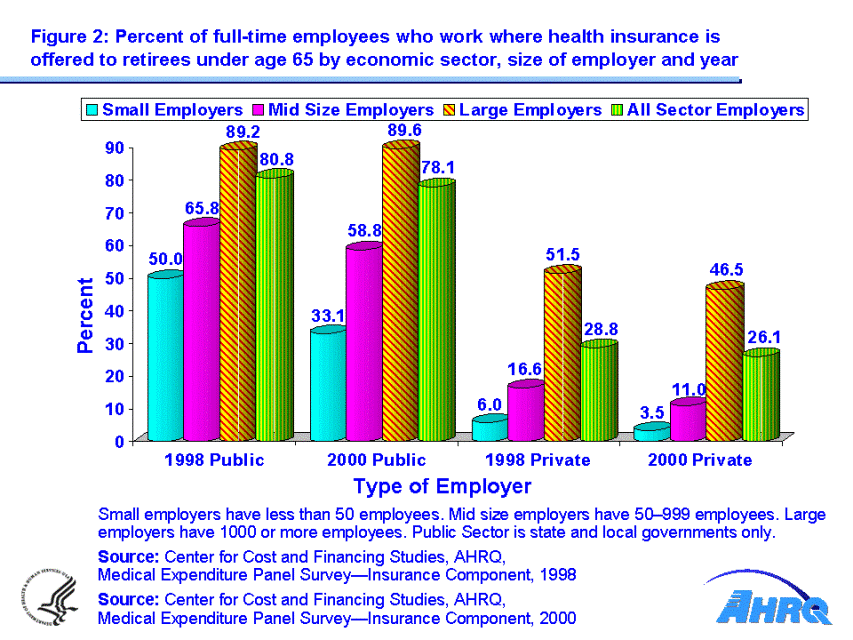
|
|
Font Size:
|
||||
|
|
|
|
||||
STATISTICAL BRIEF #17:
Employer Sponsored Health Insurance for Full Time Employees and Retirees: 1998 and 2000
Briefly Stated
- Other than full-time employees with small employers, almost all full-time private sector employees worked where health insurance was offered. The overall rate did not change significantly between 1998 and 2000.
- A larger percent of full-time state and local government employees worked where health insurance was offered to retirees than full-time employees in the private sector.
- Within both the public and private sectors, the percent of full-time employees who worked where health insurance was offered to retirees increased with the size of the employer.
- With the exception of large governments, the percent of full-time employees who worked where health insurance was offered to retirees fell from 1998 to 2000.
- The percent of full-time employees who worked where health insurance was offered to retirees age 65 and over was usually lower than the percent who worked where health insurance was offered to retirees under age 65.
Introduction
Employer sponsored health insurance for current workers is one of the primary sources of health coverage in the United States. According to data from the 2000 Medical Expenditure Panel Survey Insurance Component (MEPS-IC), approximately 97 million of the 104 million full-time employees from the private sector and state and local governments worked in establishments where the employer offered health insurance. Furthermore, 73 million of these employees were enrolled in a health insurance plan offered through their place of work.
Another valuable employment benefit is employer sponsored health insurance for retirees. Relative to the near universal availability of employer sponsored health insurance for current full-time employees, the availability of employer sponsored health insurance for retirees is limited and varies by economic sector and size of the employer.
Using data from the 1998 and 2000 MEPS-IC, this analysis examines the availability of employer sponsored health insurance for full-time employees and retirees, controlling for economic sector and size of employer. In this study, a small employer was defined as an employer with less than 50 employees, a mid size employer had 50-999 employees and a large employer had 1000 or more employees.
Findings
In 2000, 92.0% (Figure 1) of private sector full-time employees and 99.9% (Figure 1) of full-time state and local government employees worked where health insurance was offered. These estimates were essentially unchanged from those observed in 1998. The percent of full-time employees who worked at small private sector firms which offered health insurance in 2000 was 74.3% (Figure 1). Of full-time employees at large and mid size private sector firms and state and local governments almost all worked where health insurance was offered in 2000 (Figure 1). These estimates have not changed significantly from those in 1998.
Among full-time employees of all state and local governments in 2000, 78.1% (Figure 2) worked where health insurance was offered to retirees under 65. The comparable estimate for private sector full-time employees was 26.1% (Figure 2). Both these estimates represent a decline in retiree coverage relative to the corresponding values in 1998, 80.8% for the governments and 28.8% for the private sector (Figure 2).
Most of these overall patterns held for individual groups. The exception was large governments. The percent of full-time employees in large state and local governments who worked where health insurance was offered to retirees under age 65 in 2000 was 89.6% (Figure 2). The corresponding estimate for 1998 for these large governments was 89.2%. Among small governments in 2000, 33.1% (Figure 2) of the full-time employees worked where health insurance was offered to retirees under age 65. The corresponding estimate was 58.8% (Figure 2) for mid size governments. Both estimates represent a significant decline from 1998.
In 2000, full-time workers at large, mid size and small sector private sector firms were less likely to work where insurance was offered to retirees under age 65 than employees in similar sized state and local governments (Figure 2). At small firms in the private sector, only 3.5% (Figure 2) worked where health insurance was offered to retirees under age 65. At mid size private sectors firms, 11.0% (Figure 2) worked where health insurance was offered to retirees under 65, relative to 46.5% (Figure 2) for the large private sector firms.
The availability of retiree coverage declined significantly in all groups from 1998 to 2000 (Figure 2), except for large governments. In particular, at small governments, the percent of full-time employees who worked where health insurance was offered to retirees under age 65 declined from 50.0% in 1998 to 33.1% in 2000 (Figure 2). For mid size governments the rate decreased from 65.8% to 58.8% (Figure 2).
Within the private sector over the same time period, the comparable estimate for small firms declined from 6.0% to 3.5% (Figure 2), among mid size firms, the decrease was from 16.6% to 11.0% (Figure 2) and for large private sector firms the decrease was from 51.5% to 46.5% (Figure 2).
The percent of full-time employees who worked where retirees age 65 and older were offered health insurance was generally lower than the corresponding estimates in the same year for retirees under age 65. In 2000, 80% of the full-time employees of large governments worked where health insurance was offered to retirees age 65 and older (Figure 3), whereas 89.6% worked where such insurance was offered to retirees under age 65 (Figure 2). The exception was noted in small private sector firms, where the rates across age groups for retirees did not significantly differ. In 1998, the former rate was 6.0% (Figure 2) and the latter rate was 6.2% (Figure 3).
Relationships between the groups of employers for rates of full time employees who worked where health insurance was offered to retirees 65 and over were the same as the relationships previously discussed for rate for retirees under age 65. These relationships were: (1) rates decreased within sectors as the size of employer decreased, (2) rates for similar sized employers in governments were larger than the corresponding private sector rates and (3) rates fell for all groups except large governments between the years 1998 and 2000 (Figure 2 and Figure 3).
Definitions
In this statistical brief, an employer is defined as a government or private sector firm. A firm is defined as a business entity which controls one or more business establishments or locations. Thus, an employer, whether they be public or private can have multiple work locations. For example, an employer would be a city rather than an individual library location controlled by the city. Likewise, for this analysis, a large multi location auto maker is an employer and a single production plant is not.
Only those differences between years or type employer that are statistically significant at the .05 level are discussed.
This analysis focused on employers from both the public and private sector with two exceptions:
- the federal government is not included and
- self employed individuals with no other employees are not included.
About MEPS-IC
The MEPS-IC is a survey of business establishments and governments which collects information on employer sponsored health insurance, such as, whether insurance is offered, enrollments, types of plans and premiums. The survey is conducted annually by the United States Bureau of the Census under the sponsorship of the Agency for Healthcare Research and Quality (AHRQ). The yearly response rate has averaged 78% for in-scope sample units. Approximately 4% of the original sample has been out-of-scope in a typical year. A total sample of 42,000 establishments was selected for the 2000 survey, prior to accounting for losses due to non-response and out-of-scope cases. A total sample of 42,000 establishments was selected for the 2000 survey, prior to accounting for losses due to non-response and out-of-scope cases. For more information on this survey see MEPS Methodology Reports 6, 8, and 10 and the MEPS-IC Technical Appendix, available on the MEPS Web site (http://www.meps.ahrq.gov).
 |
|||||||||||||||||||||||||||||||||||
|
|||||||||||||||||||||||||||||||||||
|
|
|||||||||||||||||||||||||||||||||||
 |
|||||||||||||||||||||||||||||||||||
|
|||||||||||||||||||||||||||||||||||
|
|
|||||||||||||||||||||||||||||||||||
 |
|||||||||||||||||||||||||||||||||||
|
|||||||||||||||||||||||||||||||||||
|
|
|||||||||||||||||||||||||||||||||||


